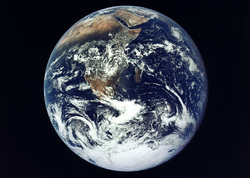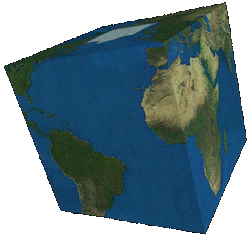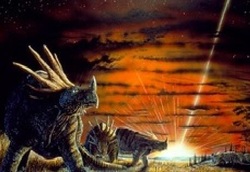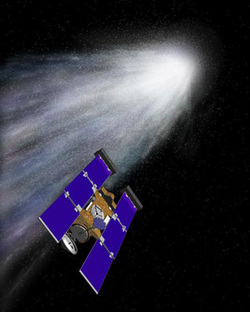Our Planet

To know more about how the universe can destroy our planet, you'll need to learn more about the planet itself. Our planet, Earth, is ideal to sustain life. It is in what astronomers call the 'Goldilocks Zone', the area of a solar system that isn't too hot or too cold. This zone is the zone of a solar system ideal for supporting life. Water is vital for life, and water can only form if the temperature is steady, so it won't rise too much or fall drastically. Our planet also is gifted with an atmosphere to protect our planet from the harmful effects of radiation form our sun. Life probably formed on our planet when a meteorite, containing organic materials, crashed into our planet. This may have been how life started on our planet. Currently, our planet is the only planet which is known to contain life.
This video will get you to see how tiny Earth is compared to the stars.
Old ideas

There are many old ideas of what our planet is, but most of these are not true. The Ancient Indians believed that they lived on a plate, lying on four elephants, which are standing on a turtle, which is swimming in a sea. The Ancient Greeks were the first civilization who became interested in astrology. Aristotle, a famous Greek astrologer, believed that the Earth was stationary at the centre of the universe.
Years on, a scientist called Galileo Galilei contradicted Aristotle. However, everyone at his time believed all of Aristotle theories, and the church even took on his idea of the Earth being stationary at the centre of the universe. You may have heard of Galileo. He was the first person to make a telescope, and even observed that Satrun had ''ears''. They were actually the rings of Saturn. Galileo was vastly outspoken and even locked in jail due to his beliefs. There was nothing he liked more than a good debate, and even challenged the Church's belief that the Earth was stationary at the centre of the universe. He managed to get people doubting the Church's version of the universe.
Christopher Columbus defied what many of the scientists of his time believed by sailing to America. At that time, many believed that or planet was flat or cube-shaped, and that Columbus would sail over the edge of the world. Most of his crew thought the same until
Nicholas Copernicus was the first scientist who actually published a book, in 1543, about Galileo's theory that the Earth revolved around the Sun. He got people talking and seriously considering Galileo's theories.
The year of Galileo's death, a brilliant, well-known scientist, Issac Newton, was born. He invented calculus and the theory of gravity, but he was famous for other things too. His theory of gravity made him wonder why the Earth didn't crash into the Sun. He concluded that the Earth must be travelling at a certain speed to avoid colliding with the Sun. However, there were many other theories, like Descartes, who believed a great, invisible sea swept the Earth around the Sun. Descartes' theory didn't have any evidence, so Issac Newton set out to search for some.
There are many other scientist who contributed to the knowledge we now have about our planet. Their names have been forgotten or wiped from history, but their knowledge was legendary and often unrivaled.
Years on, a scientist called Galileo Galilei contradicted Aristotle. However, everyone at his time believed all of Aristotle theories, and the church even took on his idea of the Earth being stationary at the centre of the universe. You may have heard of Galileo. He was the first person to make a telescope, and even observed that Satrun had ''ears''. They were actually the rings of Saturn. Galileo was vastly outspoken and even locked in jail due to his beliefs. There was nothing he liked more than a good debate, and even challenged the Church's belief that the Earth was stationary at the centre of the universe. He managed to get people doubting the Church's version of the universe.
Christopher Columbus defied what many of the scientists of his time believed by sailing to America. At that time, many believed that or planet was flat or cube-shaped, and that Columbus would sail over the edge of the world. Most of his crew thought the same until
Nicholas Copernicus was the first scientist who actually published a book, in 1543, about Galileo's theory that the Earth revolved around the Sun. He got people talking and seriously considering Galileo's theories.
The year of Galileo's death, a brilliant, well-known scientist, Issac Newton, was born. He invented calculus and the theory of gravity, but he was famous for other things too. His theory of gravity made him wonder why the Earth didn't crash into the Sun. He concluded that the Earth must be travelling at a certain speed to avoid colliding with the Sun. However, there were many other theories, like Descartes, who believed a great, invisible sea swept the Earth around the Sun. Descartes' theory didn't have any evidence, so Issac Newton set out to search for some.
There are many other scientist who contributed to the knowledge we now have about our planet. Their names have been forgotten or wiped from history, but their knowledge was legendary and often unrivaled.
What disasters have happened to Earth before?

There are actually many disasters that have occurred to our planet before, including the meteorite that wiped out the dinosaurs 65 million years ago. On the page Gamma-Ray bursts, there is an example of a Gamma-Ray burst happening about a billion years ago. Most of the space disasters that occurred on Earth are objects colliding with Earth.
4.5 billion years ago
The planets, moons, asteroids and comets form. The planets' gravity propels comets outward to form the distant Oort cloud, and forces most asteroids into a belt between Mars and Jupiter.
3.8 billion years ago
Many massive impacts from debris left over after planet building, batter the Earth and Moon, and the inner planets, Mercury, Venus and Mars. The impacts are large enough to keep much of their surfaces molten lava.
65 million years ago
An asteroid about 10 kilometres across crashes into what is now Mexico's Yucatan peninsula, forming a 300-km-wide crater called Chixculub. The aftermath hail of red-hot impact debris sets fires everywhere. The soot and dust of the impact and fires creates an "impact winter" lasting for many years, leading to the death of all dinosaurs and many other forms of life
49,000 Years Ago.
The Barringer Crater, also called Meteor Crater, near the city of Winslow in the northern Arizona desert of the United States was created about 49,000 years ago during the Pleistocene epoch.
50,000 years ago.
A 50-metre-wide, nickel-iron meteorite slams into what is now Arizona, forming Meteor Crater, which is Earth's best-preserved large impact crater, 4 km across.
613 BC
China's Annals record a great comet, now thought to have been the first known sighting of Halley's Comet and perhaps the earliest record of any comet.
350 BC
Aristotle suggests that comets exist in the upper atmosphere.
312 AD
Roman Emperor Constantine claims to see a vision of a cross in the sky, causing his conversion to Christianity. Some think this was a comet, others that it was the flash of a meteorite impact.
1577
Tycho Brahe measures the position of a great comet and compares it with sightings from other places on Earth, proving it is at least four times further away than the Moon.
1705
Edmond Halley makes the first prediction of the reappearance of a comet, proving that they orbit the Sun.
1801
The first asteroid, Ceres is discovered, by Italian astronomer Giovanni Piazza.
1908
An airburst over Tunguska, Siberia, flattens trees over hundreds of square miles, and the boom is heard thousands of miles away. It is later thought to be a comet that exploded high in the atmosphere. The blast released as much energy as a hydrogen bomb.
1950
Fred Lawrence Whipple proposes the "dirty snowball" model of comets. Jan van Oort proposes that comets originate from the Oort Cloud.
1960
Geologist Eugene Shoemaker proves that Meteor Crater, Arizona really was produced by an impact. It was the first impact crater identified on Earth.
1979
Luis Alvarez and colleagues publish the first paper linking the final dinosaur extinction to a massive asteroid impact.
1980
The Spacewatch survey begins, at the University of Arizona, led by Tom Gehrels. This is the first systematic search for asteroids that might impact the Earth.
1990
The Chixculub impact crater in Mexico, now buried deep below ground, is finally identified as the impact that killed the dinosaurs.
1992
Spaceguard program is created to search for all near-Earth asteroids larger than 1 kilometre across within 10 years.
1993
Comet Shoemaker-Levy 9 discovered. Resembling a string of pearls, it is the first known discovery of a comet shattered by a gravitational encounter with Jupiter. The dozens of pieces of the comet crash into Jupiter over a few hours in 1994.
1995
The NEAT (Near-Earth Asteroid Tracking) project begins at an air-force tracking telescope in Hawaii. The rate of near-Earth asteroid (NEA) discovery increases more than ten times!
1996
The first discovery is made of an asteroid with an orbit calculated to have a possibility of hitting Earth.
1999
Astronomer Rick Binzel publishes the Torino Scale. It is an attempt to stop fears about future near-Earth asteroid discoveries that have some small chance of striking Earth. It classifies all possible impacts on a scale with zero being no risk and 10 being virtually certain to cause global devastation.
2001
An asteroid is discovered that still has highest known possibility of impact. 1950 DA has 1-in-600 chance of striking Earth in 2880.
2002
It is found that the Yarkovsky Effect can significantly alter asteroid orbits and therefore could be used to move one out of harm's way, just by spray-painting it white. The Yarkovsky Effect is the effect of the colour white repelling heat and the colour black absorbing it.
2004
NASA's Stardust spacecraft flies by Comet Wild 2 on 2 January, gathering comet dust and taking close-up pictures. NASA's Deep Impact spacecraft becomes first object deliberately sent into collision with a comet, called Tempel 1, on 4 July.
4.5 billion years ago
The planets, moons, asteroids and comets form. The planets' gravity propels comets outward to form the distant Oort cloud, and forces most asteroids into a belt between Mars and Jupiter.
3.8 billion years ago
Many massive impacts from debris left over after planet building, batter the Earth and Moon, and the inner planets, Mercury, Venus and Mars. The impacts are large enough to keep much of their surfaces molten lava.
65 million years ago
An asteroid about 10 kilometres across crashes into what is now Mexico's Yucatan peninsula, forming a 300-km-wide crater called Chixculub. The aftermath hail of red-hot impact debris sets fires everywhere. The soot and dust of the impact and fires creates an "impact winter" lasting for many years, leading to the death of all dinosaurs and many other forms of life
49,000 Years Ago.
The Barringer Crater, also called Meteor Crater, near the city of Winslow in the northern Arizona desert of the United States was created about 49,000 years ago during the Pleistocene epoch.
50,000 years ago.
A 50-metre-wide, nickel-iron meteorite slams into what is now Arizona, forming Meteor Crater, which is Earth's best-preserved large impact crater, 4 km across.
613 BC
China's Annals record a great comet, now thought to have been the first known sighting of Halley's Comet and perhaps the earliest record of any comet.
350 BC
Aristotle suggests that comets exist in the upper atmosphere.
312 AD
Roman Emperor Constantine claims to see a vision of a cross in the sky, causing his conversion to Christianity. Some think this was a comet, others that it was the flash of a meteorite impact.
1577
Tycho Brahe measures the position of a great comet and compares it with sightings from other places on Earth, proving it is at least four times further away than the Moon.
1705
Edmond Halley makes the first prediction of the reappearance of a comet, proving that they orbit the Sun.
1801
The first asteroid, Ceres is discovered, by Italian astronomer Giovanni Piazza.
1908
An airburst over Tunguska, Siberia, flattens trees over hundreds of square miles, and the boom is heard thousands of miles away. It is later thought to be a comet that exploded high in the atmosphere. The blast released as much energy as a hydrogen bomb.
1950
Fred Lawrence Whipple proposes the "dirty snowball" model of comets. Jan van Oort proposes that comets originate from the Oort Cloud.
1960
Geologist Eugene Shoemaker proves that Meteor Crater, Arizona really was produced by an impact. It was the first impact crater identified on Earth.
1979
Luis Alvarez and colleagues publish the first paper linking the final dinosaur extinction to a massive asteroid impact.
1980
The Spacewatch survey begins, at the University of Arizona, led by Tom Gehrels. This is the first systematic search for asteroids that might impact the Earth.
1990
The Chixculub impact crater in Mexico, now buried deep below ground, is finally identified as the impact that killed the dinosaurs.
1992
Spaceguard program is created to search for all near-Earth asteroids larger than 1 kilometre across within 10 years.
1993
Comet Shoemaker-Levy 9 discovered. Resembling a string of pearls, it is the first known discovery of a comet shattered by a gravitational encounter with Jupiter. The dozens of pieces of the comet crash into Jupiter over a few hours in 1994.
1995
The NEAT (Near-Earth Asteroid Tracking) project begins at an air-force tracking telescope in Hawaii. The rate of near-Earth asteroid (NEA) discovery increases more than ten times!
1996
The first discovery is made of an asteroid with an orbit calculated to have a possibility of hitting Earth.
1999
Astronomer Rick Binzel publishes the Torino Scale. It is an attempt to stop fears about future near-Earth asteroid discoveries that have some small chance of striking Earth. It classifies all possible impacts on a scale with zero being no risk and 10 being virtually certain to cause global devastation.
2001
An asteroid is discovered that still has highest known possibility of impact. 1950 DA has 1-in-600 chance of striking Earth in 2880.
2002
It is found that the Yarkovsky Effect can significantly alter asteroid orbits and therefore could be used to move one out of harm's way, just by spray-painting it white. The Yarkovsky Effect is the effect of the colour white repelling heat and the colour black absorbing it.
2004
NASA's Stardust spacecraft flies by Comet Wild 2 on 2 January, gathering comet dust and taking close-up pictures. NASA's Deep Impact spacecraft becomes first object deliberately sent into collision with a comet, called Tempel 1, on 4 July.

